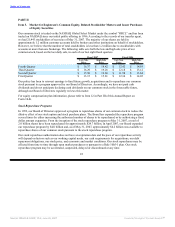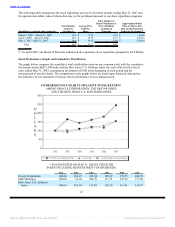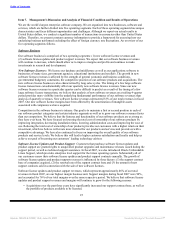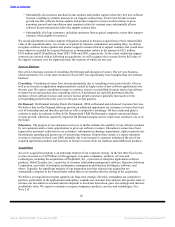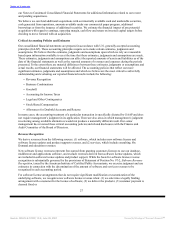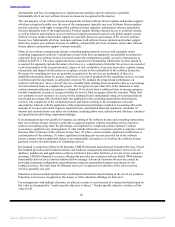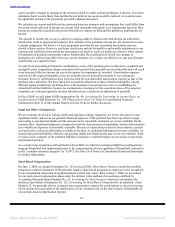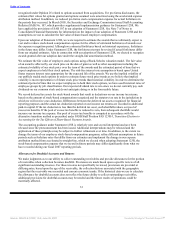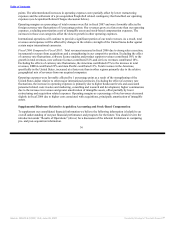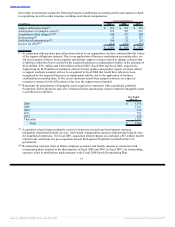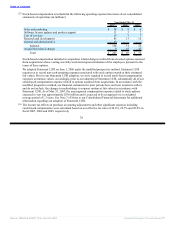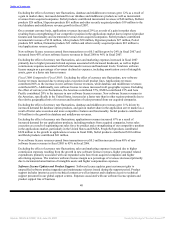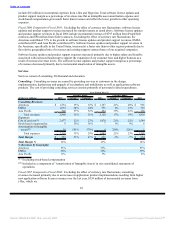Oracle 2006 Annual Report Download - page 36
Download and view the complete annual report
Please find page 36 of the 2006 Oracle annual report below. You can navigate through the pages in the report by either clicking on the pages listed below, or by using the keyword search tool below to find specific information within the annual report.
Table of Contents
assets would be charged to earnings in the period in which we make such determination. Likewise, if we later
determine that it is more likely than not that the net deferred tax assets would be realized, we would reverse
the applicable portion of the previously provided valuation allowance.
We calculate our current and deferred tax provision based on estimates and assumptions that could differ from
the actual results reflected in income tax returns filed during the subsequent year. Adjustments based on filed
returns are generally recorded in the period when the tax returns are filed and the global tax implications are
known.
The amount of income tax we pay is subject to ongoing audits by federal, state and foreign tax authorities,
which often result in proposed assessments. Our estimate of the potential outcome for any uncertain tax issue
is highly judgmental. We believe we have adequately provided for any reasonably foreseeable outcome
related to these matters. However, our future results may include favorable or unfavorable adjustments to our
estimated tax liabilities in the period the assessments are made or resolved, audits are closed or when statutes
of limitation on potential assessments expire. Additionally, the jurisdictions in which our earnings or
deductions are realized may differ from our current estimates. As a result, our effective tax rate may fluctuate
significantly on a quarterly basis.
As part of our accounting for business combinations, some of the purchase price is allocated to goodwill and
intangible assets. Impairment charges associated with goodwill are generally not tax deductible and will result
in an increased effective income tax rate in the quarter the impairment is recorded. Amortization expenses
associated with acquired intangible assets are generally not tax deductible pursuant to our existing tax
structure; however, deferred taxes have been recorded for non-deductible amortization expense as part of the
purchase price allocation. We have taken into account the allocation of these identified intangibles among
different taxing jurisdictions, including those with nominal or zero percent tax rates, in establishing the
related deferred tax liabilities. Income tax contingencies existing as of the acquisition dates of the acquired
companies are evaluated quarterly and any adjustments are recorded as an adjustment to goodwill.
In fiscal 2008, we will adopt FASB Interpretation No. 48, Accounting for Uncertainty in Income Taxes, an
interpretation of FASB Statement No. 109. Please refer to Note 1 of Notes to Consolidated Financial
Statements in Item 15 of this Annual Report on Form 10-K for further discussion.
Legal and Other Contingencies
We are currently involved in various claims and legal proceedings. Quarterly, we review the status of each
significant matter and assess our potential financial exposure. If the potential loss from any claim or legal
proceeding is considered probable and the amount can be reasonably estimated, we accrue a liability for the
estimated loss. Significant judgment is required in both the determination of probability and the determination
as to whether an exposure is reasonably estimable. Because of uncertainties related to these matters, accruals
are based only on the best information available at the time. As additional information becomes available, we
reassess the potential liability related to our pending claims and litigation and may revise our estimates. Such
revisions in the estimates of the potential liabilities could have a material impact on our results of operations
and financial position.
As a result of our acquisition of PeopleSoft in fiscal 2005, we inherited contingent liabilities resulting from a
program PeopleSoft had implemented prior to the consummation of our acquisition of PeopleSoft (referred to
as the “customer assurance program” or “CAP”). See Note 16 of Notes to Consolidated Financial Statements
for further information.
Stock-Based Compensation
On June 1, 2006, we adopted Statement No. 123 (revised 2004), Share-Based Payment, under the modified
prospective method. Statement 123R generally requires share-based payments to employees to be recognized
in our consolidated statements of operations based on their fair values. Prior to June 1, 2006, we accounted
for our stock-based compensation plans under the intrinsic value method of accounting as defined by
Accounting Principles Board Opinion No. 25, Accounting for Stock Issued to Employees and applied the
disclosure provisions of Statement No. 123, Accounting for Stock-Based Compensation, as amended. Under
Opinion 25, we generally did not recognize any compensation expense for stock options as the exercise price
of our options was equivalent to the market price of our common stock on the date of grant. Substantially all
of our stock-based compensation expense
32
Source: ORACLE CORP, 10-K, June 29, 2007 Powered by Morningstar® Document Research℠


